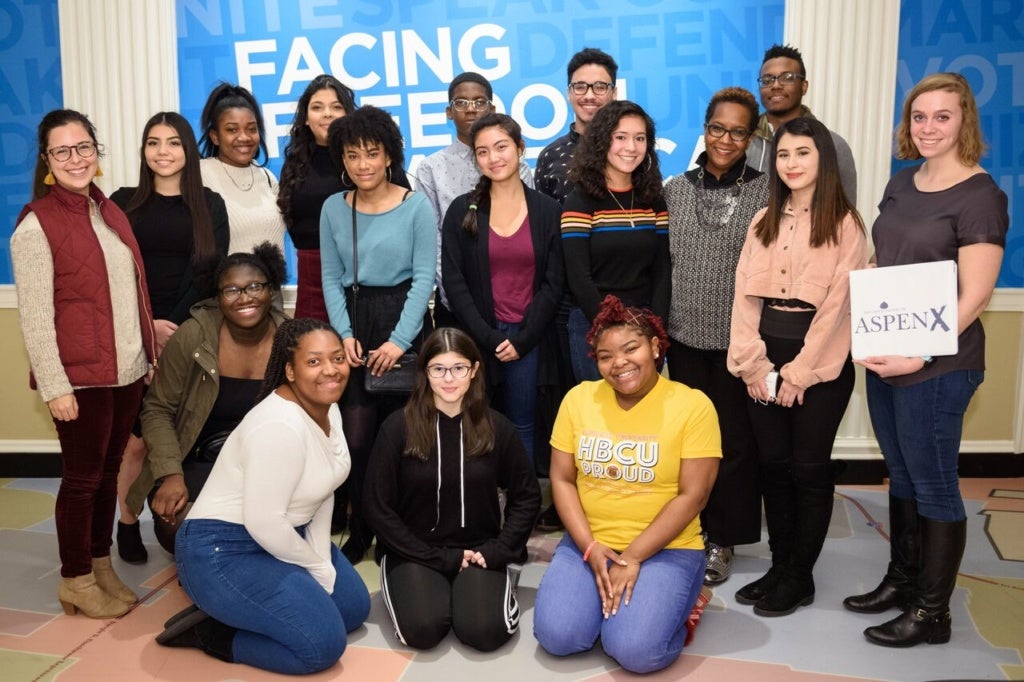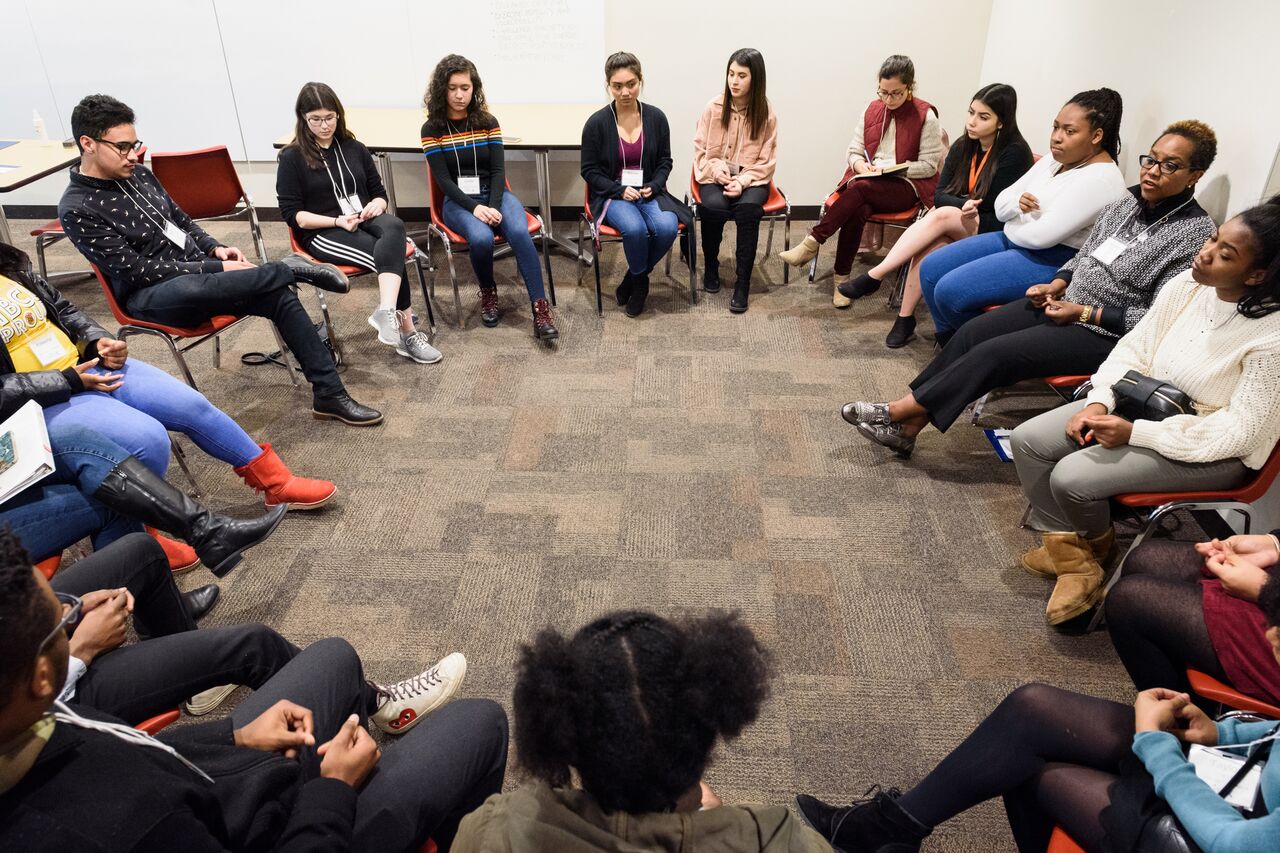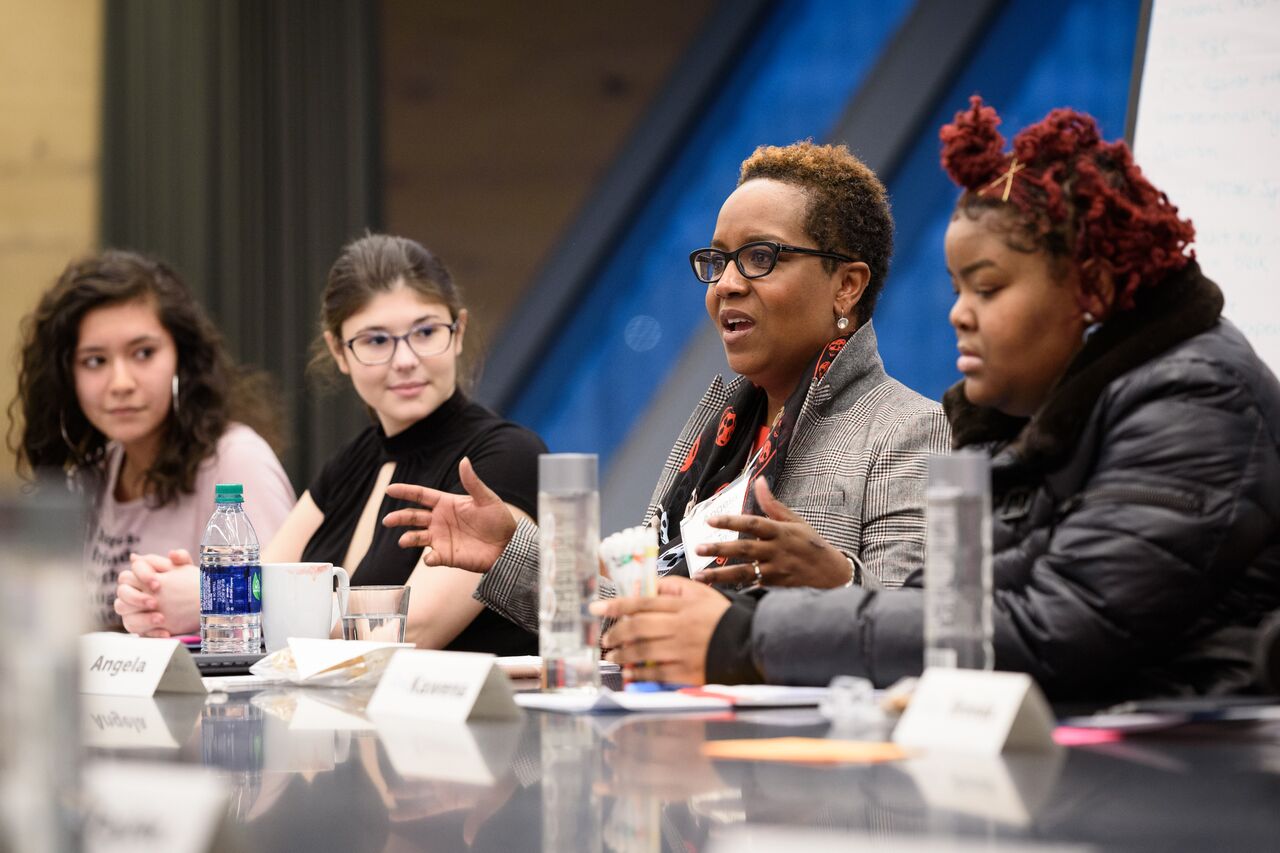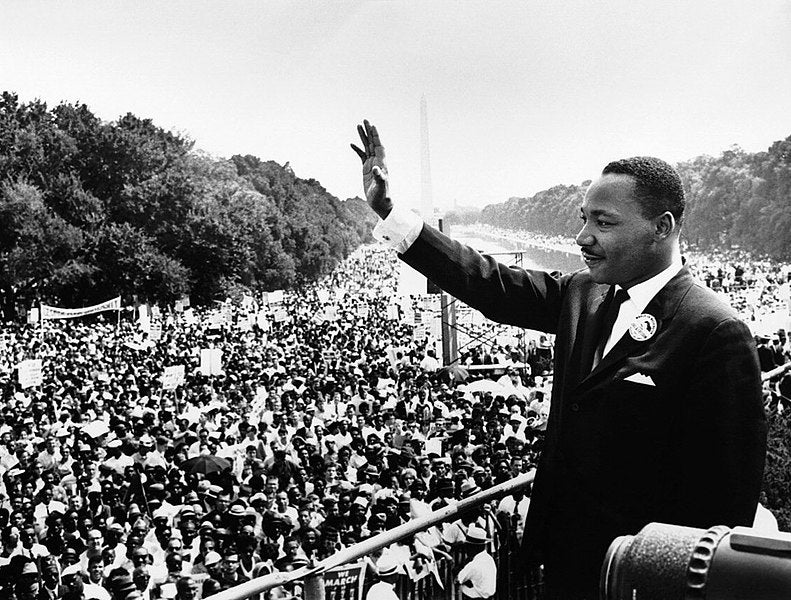Segregated neighborhoods and schools keep many of Chicago’s youth from crossing paths, building bridges, discovering solidarity, and hearing each other’s stories. This past weekend, however, AspenX brought together students from every corner of Chicago, breaking down silos across age, ethnicity, nationality, sexuality, and more. Together, these students learned about and discussed race through an intersectional lens and began to develop their ideas on how to create a more equitable future.
AspenX is a two-day program where high school students take a deep dive into critical issues of the day through virtual and experiential learning coupled with expert-moderated, in-person dialogue.
Students began the first day of the program with experiential learning at the Chicago History Museum, where museum volunteers John Quinn and Penny Applegate guided participants through the museum’s Facing Freedom in America exhibition.

Photo by Michael Courier
Through a guided conversation and object-based learning activity, participants explored the ever-changing and incomplete definition of freedom in America, and the ongoing fight to expand who has freedom and in what ways.
The discussion focused on four historical events – Japanese internment, the United Farm Workers’ grape boycott, women’s suffrage movement, and slavery – each representing various ways in which freedom, or the loss thereof, has shaped our country’s narrative and the numerous communities who have fought for equity throughout history. As Epic Academy student Caitlyn Gill looked at the dates each of these events occurred, she realized that the fight for these freedoms was in the not-so-distant past. Others noted the ways in which these historical injustices mirror today’s injustices – the suffrage movement and white feminism, the grape farmers and minimum wage workers, and Japanese internment and immigrant holding facilities. Lane Tech College Prep senior Daniel Dardon noted that, by not teaching this hard history, we’re setting ourselves up to continue this repetition of injustices.
After touring and discussing the exhibit, the group spent time digging deeper on the issue of race and equity through a pen pal activity. Before seminar, participants selected one reading or video from a pre-set list to write a reflection on and were matched with another participant who chose the same option. These “pen pals” discussed their reflections and shared their thoughts on the experiences and perspectives that they believe caused the convergences and divergences between their responses. Those that chose Childish Gambino’s “This is America,” discussed that, while they agreed that the music video exemplifies the way we consume black culture while ignoring violence against the black community, they disagreed on whether the video’s depiction of teenagers on their phones was positive or negative. This echoes the real-life debates on whether social media is helping or hindering change. While those who chose Macklemore and Ryan Lewis’ White Privilege came from opposite experiences – one a beneficiary of white privilege, one impacted by white supremacy – they could share a common commitment to creating equity and justice and building allyship. The third group read an article about how DACA “pits ‘good immigrants’ against other immigrants,” and shared the ways they’ve personally felt, or seen others feel, the pressure to dispel stereotypes and engage in competition against other minorities. The final group, which listened to a podcast on a phenomenon called “racial imposter syndrome,” shared the ways they’ve each felt like an imposter within their own racial communities, and highlighted how great of an influence hair, skin color, and beauty standards have on racial identity and acceptance.

Photo by Michael Courier
The following day, students reconvened at the Hyatt Hotel Headquarters to build and reflect on the prior day’s learning as it applies to their own identities, others’ perspectives and experiences, and how this informs their path forward. Founder & CEO of FirstGen Partners LLC and Pahara-Aspen Education Fellow Angela Cobb led the conversation to help the group uncover the numerous ways race influences their own lives, the lives of those around them, and their broader communities.
The first module began with watching a clip from Kimberlé Crenshaw’s TED Talk “The Urgency of Intersectionality,” which introduces the term “intersectionality” and provided an avenue for students to explore the ways their many identities intersect to shape their lived experience. Responding to Crenshaw’s discussion of the coverage of police violence against black men, many discussed the recent verdict for the murder of Laquan McDonald at the hands of Jason Van Dyke. King College Prep’s Kawena Jackson noted that events like this hit home for people of color, since they can empathize with the threat of violence, and others responded that intersectionality can help bridge those empathy gaps by bringing in the many communities who are impacted by the same or similar issues. Participants also noted that, in thinking about one’s many identities, it is important to not only think about which of those identities cause oppression, but which bring privilege.
Next, students discussed Elizabeth C. Leung’s “My Country ‘Tis Not of Thee,” which chronicles her never-ending journey to understand her identity as an Asian-American woman, navigating between feeling too Asian to be truly American, but too American to be accepted back in her native China. For high school seniors like Jorge Mendez, the issue of diversity and inclusion is especially important for people of color searching for a college that will make them feel welcome. Many empathized with Leung’s narrative and referred to the previous day’s discussion on “racial imposter syndrome.” From being a person of color with a “white” name, to not speaking your native language fluently “enough,” stereotypes, expectations, a lack of representation, and bad representation made many feel as though they weren’t enough to belong. Sharing this experience helped many realize they weren’t alone and created the shared identity of having uncertain identities.

AspenX moderator Angela Cobb. Photo by Michael Courier.
Students then explored the many communities impacted by and activists organizing against gun violence and police brutality, including the students from Parkland, Chicago youth, and the Latinx community, as well as the discrepancies in how and whether they each receive public support and awareness. While many had seen discrepancies in how violence against each community was covered, Saint Ignatius College Prep junior Montse Villalobos highlighted that, if each of these communities comes together in coalition, the movement against gun violence will be stronger. In groups, participants began practicing how to build those coalitions and outlined ways to draw broader community support.
To begin to think about next steps, students watched spoken-word poet Amal Kassir’s “At The Table.” Amal’s piece calls into question who we do and don’t give a seat at the table, exemplifies the impact that has on communities, and proposes that we flip the script by inviting our country’s leaders to sit at marginalized communities’ tables instead. Drawing from the day’s earlier discussion Saint Ignatius College Prep junior Taylor Trimble underlined that “you need intersectionality at the table in order for everyone’s voices to be heard.” Many agreed that young people, and more broadly people who look like them, are often not given a seat at the table. Some reflected on the ways they’ve been told to keep their head down, to not speak unless spoken to, and why it’s important that they do use their voice.
Creating their own decision-making table, students culminated their experience and discussion by brainstorming ways to use what they learned at AspenX to create solutions to racial inequities in their communities. They addressed the link between the education system and prison system, the lack of hope and confidence that Hispanic students and DACA recipients have, as well as the need to speak up against injustice. Their solutions included modernizing the educational curriculum, creating spaces for Hispanic students to find community amongst each other, and creating afterschool clubs like AspenX.
While sharing Snapchat handles and cell phone numbers, buzzing over dinner plans and coordinating schedules, participants left committed to not only maintaining the friendships they had made, but also continuing the important work they had started together.

